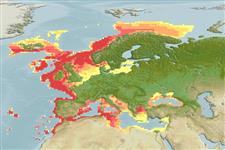Classification / Names
Common names from other countries
Main reference
Size / Weight / Age
Max length : 200 cm SL male/unsexed; (Ref. 4712); common length : 100.0 cm SL male/unsexed; (Ref. 4712); max. published weight: 57.7 kg (Ref. 40637); max. reported age: 24 years (Ref. 46508)
Length at first maturity
Lm ?, range 35 - 60 cm
Environment
Marine; bathydemersal; depth range 20 - 1000 m (Ref. 6302)
Climate / Range
Deep-water, preferred 11°C (Ref. 107945); 75°N - 30°N, 28°W - 46°E (Ref. 54568)
Distribution
Eastern Atlantic: south-western Barents Sea to Strait of Gibraltar including the Mediterranean and Black Sea. Reported from Iceland (Ref. 4712) and Mauritania (Ref. 5377). North Atlantic specimens attain larger sizes than those collected off West Africa and they also occur in shallower depths.
Countries | FAO areas | Ecosystems | Occurrences | Introductions
Short description
Dorsal
spines
(total): 8;
Dorsal
soft rays
(total): 11-12;
Anal
soft rays: 9 - 10. Peritoneum pale. Head and body depressed. Mouth wide and cavernous. Skin thin and loose, scales absent. Esca bifid, 2 broad, flattened , leaf-like blades. Dorsal spines long, stout and bearing many well-developed tendrils; 4th spine greater than snout width (Ref. 4712).
IUCN Red List Status (Ref. 115185)
Threat to humans
Harmless
Human uses
Fisheries: highly commercial
Tools
Special reports
Download XML
Internet sources
Estimates of some properties based on models
Phylogenetic diversity index
PD50 = 0.5078 many relatives (e.g. carps) 0.5 - 2.0 few relatives (e.g. lungfishes)
Trophic Level
4.5 ±0.1 se; Based on diet studies.
Resilience
Medium, minimum population doubling time 1.4 - 4.4 years (K=0.07-0.33; tm=4.5-14; tmax=24; Fec=1 million)
Vulnerability
High to very high vulnerability (72 of 100)
Price category
